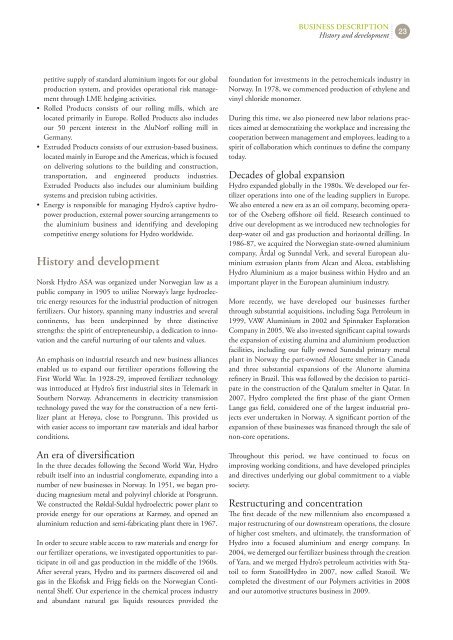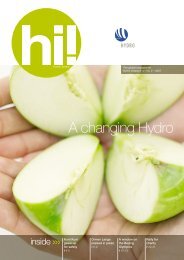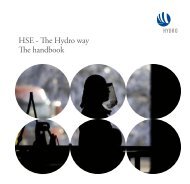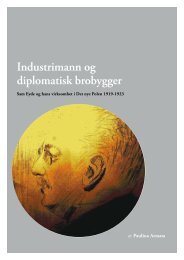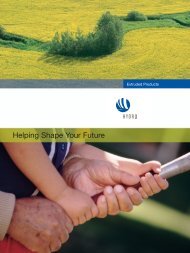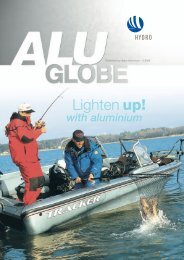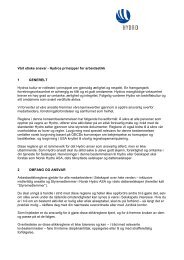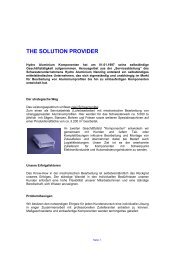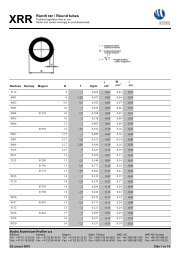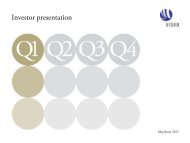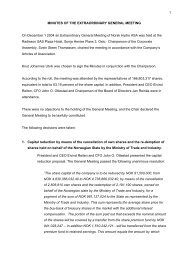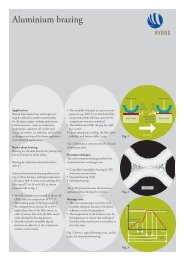Hydro Annual Report 2011b
Hydro Annual Report 2011b
Hydro Annual Report 2011b
Create successful ePaper yourself
Turn your PDF publications into a flip-book with our unique Google optimized e-Paper software.
petitive supply of standard aluminium ingots for our global<br />
production system, and provides operational risk management<br />
through LME hedging activities.<br />
• Rolled Products consists of our rolling mills, which are<br />
located primarily in Europe. Rolled Products also includes<br />
our 50 percent interest in the AluNorf rolling mill in<br />
Germany.<br />
• Extruded Products consists of our extrusion-based business,<br />
located mainly in Europe and the Americas, which is focused<br />
on delivering solutions to the building and construction,<br />
transportation, and engineered products industries.<br />
Extruded Products also includes our aluminium building<br />
systems and precision tubing activities.<br />
• Energy is responsible for managing <strong>Hydro</strong>’s captive hydropower<br />
production, external power sourcing arrangements to<br />
the aluminium business and identifying and developing<br />
competitive energy solutions for <strong>Hydro</strong> worldwide.<br />
History and development<br />
Norsk <strong>Hydro</strong> ASA was organized under Norwegian law as a<br />
public company in 1905 to utilize Norway’s large hydroelectric<br />
energy resources for the industrial production of nitrogen<br />
fertilizers. Our history, spanning many industries and several<br />
continents, has been underpinned by three distinctive<br />
strengths: the spirit of entrepreneurship, a dedication to innovation<br />
and the careful nurturing of our talents and values.<br />
An emphasis on industrial research and new business alliances<br />
enabled us to expand our fertilizer operations following the<br />
first World War. In 1928-29, improved fertilizer technology<br />
was introduced at <strong>Hydro</strong>’s first industrial sites in Telemark in<br />
Southern Norway. Advancements in electricity transmission<br />
technology paved the way for the construction of a new fertilizer<br />
plant at Herøya, close to Porsgrunn. This provided us<br />
with easier access to important raw materials and ideal harbor<br />
conditions.<br />
An era of diversification<br />
In the three decades following the Second World War, <strong>Hydro</strong><br />
rebuilt itself into an industrial conglomerate, expanding into a<br />
number of new businesses in Norway. In 1951, we began producing<br />
magnesium metal and polyvinyl chloride at Porsgrunn.<br />
We constructed the Røldal-Suldal hydroelectric power plant to<br />
provide energy for our operations at Karmøy, and opened an<br />
aluminium reduction and semi-fabricating plant there in 1967.<br />
In order to secure stable access to raw materials and energy for<br />
our fertilizer operations, we investigated opportunities to participate<br />
in oil and gas production in the middle of the 1960s.<br />
After several years, <strong>Hydro</strong> and its partners discovered oil and<br />
gas in the Ekofisk and frigg fields on the Norwegian Continental<br />
Shelf. Our experience in the chemical process industry<br />
and abundant natural gas liquids resources provided the<br />
BusIness DesCrIptIon<br />
History and development<br />
23<br />
foundation for investments in the petrochemicals industry in<br />
Norway. In 1978, we commenced production of ethylene and<br />
vinyl chloride monomer.<br />
During this time, we also pioneered new labor relations practices<br />
aimed at democratizing the workplace and increasing the<br />
cooperation between management and employees, leading to a<br />
spirit of collaboration which continues to define the company<br />
today.<br />
Decades of global expansion<br />
<strong>Hydro</strong> expanded globally in the 1980s. We developed our fertilizer<br />
operations into one of the leading suppliers in Europe.<br />
We also entered a new era as an oil company, becoming operator<br />
of the Oseberg offshore oil field. Research continued to<br />
drive our development as we introduced new technologies for<br />
deep-water oil and gas production and horizontal drilling. In<br />
1986-87, we acquired the Norwegian state-owned aluminium<br />
company, Årdal og Sunndal verk, and several European aluminium<br />
extrusion plants from Alcan and Alcoa, establishing<br />
<strong>Hydro</strong> Aluminium as a major business within <strong>Hydro</strong> and an<br />
important player in the European aluminium industry.<br />
More recently, we have developed our businesses further<br />
through substantial acquisitions, including Saga Petroleum in<br />
1999, vAW Aluminium in 2002 and Spinnaker Exploration<br />
Company in 2005. We also invested significant capital towards<br />
the expansion of existing alumina and aluminium production<br />
facilities, including our fully owned Sunndal primary metal<br />
plant in Norway the part-owned Alouette smelter in Canada<br />
and three substantial expansions of the Alunorte alumina<br />
refinery in Brazil. This was followed by the decision to participate<br />
in the construction of the Qatalum smelter in Qatar. In<br />
2007, <strong>Hydro</strong> completed the first phase of the giant Ormen<br />
Lange gas field, considered one of the largest industrial projects<br />
ever undertaken in Norway. A significant portion of the<br />
expansion of these businesses was financed through the sale of<br />
non-core operations.<br />
Throughout this period, we have continued to focus on<br />
improving working conditions, and have developed principles<br />
and directives underlying our global commitment to a viable<br />
society.<br />
Restructuring and concentration<br />
The first decade of the new millennium also encompassed a<br />
major restructuring of our downstream operations, the closure<br />
of higher cost smelters, and ultimately, the transformation of<br />
<strong>Hydro</strong> into a focused aluminium and energy company. In<br />
2004, we demerged our fertilizer business through the creation<br />
of yara, and we merged <strong>Hydro</strong>’s petroleum activities with Statoil<br />
to form Statoil<strong>Hydro</strong> in 2007, now called Statoil. We<br />
completed the divestment of our Polymers activities in 2008<br />
and our automotive structures business in 2009.


